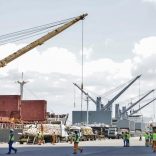Mozambique: Tobacco export revenue up 41% in 2024 to US$217.2 million
“That situation does not exist” – Minister denies FEWS NET warning of worst food insecurity since 2016 – A Verdade

Photo: A Verdade
In the past week the United Nations Organisation Network of Early Warning Systems of Hunger (FEWS) has warned that Mozambique faces its worst food insecurity since 2016 and that an atypical and high number of families are in a food shortage situation.
Confronted by @Verdade, Minister of Agriculture and Food Security Higino de Marrule said, “That situation does not exist”.
The most recent publication by FEWS NET [Famine Early Warning Systems Network], a United States Agency for International Development (USAID) entity, warns of a humanitarian emergency resulting from to the passage of cyclones Desmond, Idai and Kenneth, torrential rains and floods in the centre and north of Mozambique, and drought in the south.
The publication indicates that, “in surveyed districts” [39 in total, surveyed by the Technical Secretariat of Food Security and Nutrition (SETSAN)], 67,500 children aged 6-59 months are suffering from acute malnutrition, of which 6,500 are suffering from severe acute malnutrition (SAM).
FEWS NET reports that between May and June, humanitarian assistance to hungry populations had reached 1.6 million people in cyclone-affected districts in the central and northern parts of the country, but added that “it is expected that there are still households that are not receiving assistance at all or households are receiving very small amounts of food assistance”.
“The 2018/19 crop production will be significantly below last year’s production and the 5-year average,” the report reads, warning that households that still have food reserves may be left with nothing by September because of a significantly smaller harvest.
Confronted with the document’s findings by @Verdade, Minister de Marrule said that the food insecurity situation as described “Is a new thing to me”.
“The FEWS NET? That is the information they have, that situation does not exist,” said the minister, esplaining: “We had that situation of cyclones that reached 1.5 million people, that’s a fact. After the cyclone, we have a situation of 1.5 million people who have lost almost everything. They are in the process of recovery. The initial effort we made, together with FAO and other partners, was the distribution of seeds. Some of them are already reaping. Others are in a situation where they are still sowing, but we have the WFP and other organisations issuing food supplements until next year.”
De Marrule, accompanied by Mozambique FAO representative Olman Serrano, added that: “Last week the Council of Ministers rescinded National Emergency status, so the Government is so irresponsible to the point of dismantling, it would be counterproductive.”
By Adérito Caldeira
About FEWS NET
FEWS NET, the Famine Early Warning Systems Network, is a leading provider of early warning and analysis on acute food insecurity. Created in 1985 by the US Agency for International Development (USAID) after devastating famines in East and West Africa, FEWS NET provides objective, evidence-based analysis to help government decision-makers and relief agencies plan for and respond to humanitarian crises.
Analysts and specialists in 19 field offices work with US government science agencies, national government ministries, international agencies, and NGOs to produce forward-looking reports on 28 of the world’s most food-insecure countries.
Mozambique Food Security Outlook, June 2019 to January 2020
- REPORT from Famine Early Warning System Network Published on 21 Jun 2019
Atypically high humanitarian assistance needs will persist through the start of the lean season
Key messages
• Mozambique is experiencing its worst food insecurity emergency since the 2015/16 drought with an atypically high number of households in need of emergency assistance. This is the result of multiple shocks including tropical cyclones Desmond, Idai, and Kenneth with associated torrential rainfall and severe flooding and drought in southern semiarid areas. These shocks have significantly impacted crop production across the country and livelihoods, specifically in Cyclone affected areas.
• Most of the country is facing Stressed (IPC Phase 2) and Crisis (IPC Phase 3) outcomes. In southern semiarid areas this is the second consecutive poor season and households have little to no food stocks, which is atypical for this time of year. Tropical Cyclone affected households lost their crops for the 2019/20 consumption year and are continuing to rebuild their livelihoods. The rest of the country is experiencing Minimal (IPC Phase 1) outcomes due to a normal harvest.
• Due to the significantly below-average harvest, the lean season is expected to begin atypically early. Household food stocks are likely to be exhausted by September, even though efforts are ongoing to maximize the second season, which typically contributes a small portion to the annual households’ food stocks, particularly for cereals. In October/November, agricultural labor opportunities are expected to seasonally increase with the start of the rainy season, but is expected to remain below average.
• In areas most affected by this year’s shocks, namely in Gaza, Inhambane, Sofala, Manica and parts of Zambézia provinces, poor households are expected to continue engaging and increasing their reliance on livelihood coping strategies to meet their minimum food needs. The poor and very poor households are expected to continue facing Crisis (IPC Phase 3) food security outcomes in January 2020, with humanitarian food assistance needs most likely increasing until the harvest in April 2020.

National overview
Current Situation
Current estimates from the Ministry of Agriculture and Food Security (MASA) indicate over a million MT of crops were lost including corn, rice, groundnuts, beans, and vegetables were destroyed nationwide as a result of the poor rainfall in the southern semiarid areas and three Tropical Cyclones, Desmond, Idai, and Kenneth. MASA estimates nearly 800,000 MT loss in national maize grain production, representing a reduction of more than 30 percent as compared to the last two years’ average. MASA also estimates, this year’s shocks caused the death of nearly 120 cattle, 1,120 small ruminates and more than 22,000 chickens. The tropical cyclone damaged fishing boats and equipment for fishing as well as infrastructure, a key livelihood for thousands of households along the coast. Based on available information on losses caused by this year’s multiple shocks, combined with the remote sensing analysis particularly of the Water Requirements Satisfaction Index (WRSI) (Figure 1), the 2018/19 crop production will be significantly below last year’s production and the 5-year average.
Current household food stocks are much lower than average in southern semiarid areas as well as areas affected by tropical cyclones. In southern areas, as a result of the second consecutive poor season households have little to no food stocks. Most of the markets are relatively well supplied thanks to the flow of food commodities from surplus areas, including some remote areas, resulting in abnormally higher retail prices. In the rest of the country markets and households have average stocks.
As many households continue relying on markets for food, particularly in shock affected areas, poor households continue to engage in self-employment activities to access incomes. However, as more and more people engage in self-employment activities, opportunities to sell are reduced and prices decrease; limiting incomes.
Second season planting and production is progressing in the flood affected areas where households have been planting following the receding flood waters. On the other hand, in the southern semiarid areas, second season production is limited due to lack of residual moisture. As of late May, in cyclone affected areas various organizations provided nearly 150,000 kilograms of maize grain seeds and 78,000 kilograms of beans seeds to about 20,000 households. FAO is also providing agricultural inputs (assorted vegetable seeds, beans seeds and agricultural tools) to slightly over 65,900 households for second season planting. The total number of beneficiaries is most likely to be around 95,000 households with other organisations’ contribution. In the flood affected areas, prospects for second season are good due to existing residual moisture and water bodies from where households can get water for irrigation. However, production from second season is for rapid consumption and does not guarantee durable food stocking.
Generally maize grain prices across the country are decreasing or stable, although are 30 percent above the five-year average and 50 percent above last year’s prices on average (Figure 2). In the central region and parts of the northern region, some market access and trade flows were temporarily interrupted due to damage by the cyclones and flooding; however, most market function and internal trade flows have returned to normal. Due to significant crop loss, the traded volumes are well below average. From April to May, maize grain prices decreased by 17 percent on average across all monitored markets, with the largest decrease in Gorongosa market by 31 percent, followed by Nampula by 29 percent, Maputo by 25 percent, Chimoio by 19 percent, Chókwe by 17 percent, and Pemba by 13 percent. In all other monitored markets, maize grain prices remained stable. Overall the decreasing trend is the result of the increased food availability from the main harvest of 2018/19 season.
Poor households in shock affected areas are expanding their livelihoods and consumption based coping strategies to access food. Specifically, in northern districts affected by attacks by malefactors and Tropical Cyclone Kenneth. Displaced households are at risk of attacks and are reliant on markets as they also lost their crops. Some common coping strategies include reduction of quantity and frequency of meals, restricting consumption by adults for the children, and consuming less preferred foods. Households are also intensifying income generating activities such as selling their animals as possible (mostly chicken), producing and selling charcoal, firewood, construction wood poles. However, competition and reduced purchasing power in these areas is limiting the amount of income earned.
The Technical Secretariat of Food Security and Nutrition (SETSAN) carried out a food security and nutrition assessment covering 39 districts affected by drought and Tropical Cyclones Desmond, Idai, and Kenneth in April and May. In surveyed areas, Food Consumption Score (FCS) showed more than 50 percent of households had borderline to poor food consumption, indicative of Crisis (IPC Phase 3) or worse outcomes as per the IPC Reference Table. This indicator is indicative of diet quality and quantity, and depending on the context, a poor FCS does not necessarily indicate households are experiencing food consumption gaps. Especially, during large scale non-diversified humanitarian food assistance, it is possible to have a poor diet quality with a poor FCS, but not face food consumption gaps.
Household Hunger Scale (HHS) was indicative of Crisis (IPC Phase 3) in about 70 percent of analyzed districts and Stressed (IPC Phase 2) in 30 percent of districts. Reduced Coping Strategy Index (rCSI), indicated 40 percent of the assessed districts were in Crisis (IPC Phase 3) with 60 percent of households in Stressed (IPC Phase 2). These results of the food consumption outcome indicators are suggestive of Stressed (IPC Phase 2) or Crisis (IPC Phase 3) food security outcomes in surveyed areas.
The same survey indicated most households across the country are engaging in coping strategies indicative of Crisis (IPC Phase 3) or Stressed (IPC Phase 2). Some of the livelihood strategies indicative of Crisis (IPC Phase 3) and Stressed (IPC Phase 2) are the following: households spending their savings, borrowed money, harvested immature crops (e.g. green maize), borrowed food or bought food on credit, consumed seed stocks that were to be saved for the next season, and reduced expenses on health (including drugs) and education. The results from the SETSAN analysis indicate most households are employing Crisis (IPC Phase 3) and Stressed (IPC Phase 2) level coping strategies, but households have not exhausted all of the strategies available to them.
The SETSAN nutrition survey covered 31 of the 39 districts covered for the SETSAN food security assessment as well the nutrition data in Cabo Delgado were collected prior to Tropical Cyclone Kenneth. An estimated 67,500 children between 6 and 59 months of age in districts surveyed suffer from acute malnutrition as measured by weight-for-height z-score (WHZ), with slightly over 6,500 suffering from severe acute malnutrition (SAM). The prevalence of Global Acute Malnutrition (GAM) is within “Acceptable” (<5 percent) prevalence and “Poor” (5 to 9.9 percent) prevalence as per the WHO Classification. However, the one exception is Ibo district in Cabo Delgado where the GAM rate is “Serious” (10 to 14.9 percent) prevalence. This is most likely due to the fact that Ibo is an island which is isolated with a high level of chronic food insecurity and a higher incidence of disease.
As of late May, humanitarian assistance covered more than 1.6 million people in central and northern areas affected by tropical cyclones. According to partners, the population reached with humanitarian assistance in June is similar to the population reached in May. Due to the large-scale humanitarian food assistance many households are experiencing No Acute Food Insecurity! (IPC Phase 1!) and Stressed! (IPC Phase 2!) in central and northern cyclone affected areas; however, it is expected that there are still households that are not receiving assistance at all or household are receiving very small amounts of food assistance. As a result, it is expected Crisis (IPC Phase 3) area level outcomes are present. Also, it is important to note in the absence of humanitarian food assistance households in Crisis (IPC Phase 3) are not anticipated to start engaging in coping strategies indicative of Emergency (IPC Phase4). These households have not exhausted all their Crisis and Stressed level coping strategies and will continue to employ these in areas where there is no humanitarian food assistance. As stated above, since most household have not exhausted their Crisis (IPC Phase 3) and Stressed (IPC Phase 2) level livelihood coping strategies it is likely these households will engage in other livelihood coping strategies indicative of Stressed (IPC Phase 2) and Crisis (IPC Phase 3) in the absence of assistance.
Crisis (IPC Phase 3) and Stressed (IPC Phase 2) outcomes are widespread in semiarid areas affected by the drought. The rest of the country is experiencing Minimal (IPC Phase 1) and Stressed (IPC Phase 2) food security outcomes.
Assumptions
The Food Security Outlook for June 2019 through January 2020 is based on the following national-level assumptions:
- International forecasts show a continuation of a weak El Niño through 2019, which typically drive below average rainfall across Southern Africa. However, due to the relatively high uncertainty of El Niño occurrence and uncertainty inherent in El Niño-based rainfall outcomes, near average conditions are expected for the onset and first half of the 2019/20 rainfall season. The probability for the occurrence of floods and/or cyclones during the scenario period (June 2019 to January 2020) is relatively low.
- Water restrictions the southern region will most likely be decreased due to the increased water volume in the Pequenos Libombos dam following the supply from eSwatini (former Swaziland). The river levels in the central and northern region are currently above average and expected to remain at these levels for the entire scenario period.
- A larger than normal maize deficit is expected for the 2019/20 marketing year. Mozambique typically imports about 110,000 MT of maize grain on average, this year due to large maize grain deficits, maize grain imports are anticipated to be well above average. However, maize is likely to be sourced from international markets outside of Southern Africa given South Africa and Zambia, the main regional exporters are likely to have a below average supply.
- Staple food supplies in most markets is expected to remain below average throughout the country with a higher incidence in southern and central regions due to below average crop production in both regions.
- Cross border trade for maize grain with Malawi is expected to increase, particularly in areas impacted by flood where affected households on both sides of the border will likely increase the demand from border markets.
- The flow of maize grain within the southern and central regions is expected to be below average due to the limited maize availability. Northern areas, particularly Niassa and Nampula provinces, and some center surplus producing areas particularly northern Tete province and Manica province, will likely atypically become major maize grain supplies to the deficit areas in the central and southern regions. The flow of maize grain from north to south is anticipated to be normal; however, this is likely to result in increased final price for the consumers due to higher costs of transaction.
- Maize grain prices will remain above average, while maize meal and rice prices are expected to remain stable but higher than average.
- In the southern and central regions, household food availability is expected to be significantly below average due to the poor harvest and/or total crop failure during the 2018/19 main agricultural season. In most of the south, livestock body conditions are expected to deteriorate due to the poor pasture conditions and limited water availability until pasture conditions start regenerating in November. This will most likely lead to households overselling livestock to avoid deaths or alternatively migrating livestock longer distances in search of pasture and water. As a result, livestock prices are expected to be slightly below average due to poor body conditions and increased supply.
- The availability of wild foods is expected to be below average throughout the entire scenario period due to drought conditions in south and the extreme weather events in the central and northern regions.
- Households affected by cyclones and floods in the centre and north are likely to avoid selling their animals to begin recover and existing residual moisture will favor pasture growth; encouraging the retention of their animals.
- The second season typically contributes approximately 10 to 20 percent of total annual production. For the southern region, prospects for the second season are poor due to the significantly below average residual moisture. On the other hand, in the central and northern regions, second season production will likely be significantly above average.
- From October 2019 to January 2020, as the new season starts, the proliferation of pests will most likely typically occur. However, the level of infestation will depend on the progress of the season with suppressed rainfall usually favouring the occurrence of pests including fall armyworm (FAW), grasshoppers, stalk borer, leafminer, and rodents.
- As is typical, from June to August, agricultural labor activities will most likely be above average as most agriculture-related activities are restricted to second season. From September to January, agricultural labor opportunities are expected to gradually increase but remain below average. Overall, wages are expected to be well below average due to the majority of households have exhausted their income due to two consecutive years of poor harvest in the southern region, while in the central region, most affected households had no opportunity to earn income from the 2018/19 main harvest and existing savings will likely be used to purchase food from markets, reconstruct households, and recover livelihoods.
- Due to the likely increase in the number of people engaging in self-employment activities across the country, opportunities to sell services and/or goods and earn income are anticipated to decline and be below average.
Increased food access from the on-going and second season harvests is expected to sustain an “Acceptable” and “Poor” levels of acute malnutrition throughout the June to January 2020 period, however some districts previously in “Acceptable” may deteriorate “Poor”. - Available and current information, humanitarian food assistance is most likely to continue at current levels in central and northern areas through at least November.
- Sporadic attacks are likely and expected to continue at current levels given the difficulty in predicting conflict in some districts of Cabo Delgado. From October/November, the attacks will most likely disrupt farming activities and households will most likely be unable to produce own foods.
Most likely food security outcomes
From June to September 2019, most poor households across the country are expected to meet their basic food needs by consuming own foods from the 2018/19 main season harvest complemented by food purchases from the markets. As a result, these households will most likely face Minimal (IPC Phase 1) acute food insecurity outcomes. However, in the areas affected by drought, cyclones, and flooding, most poor households are anticipated to continue facing Crisis (IPC Phase 3) and Stressed (IPC Phase 2). Throughout the scenario period, households are likely to continue to recover from the multiple shocks and rebuild their livelihoods. Typically, most of these households would be consuming own food; however, this year, food access is anticipated to be constrained due to the abnormally high market prices and decreased availability of own foods. Although household availability of food is likely to increase due to the above average second season harvest. These households are anticipated to continue using coping strategies including reducing the frequency and quantity of meals, relying on less expensive foods, borrowing food from relatives or better off households, and consuming less preferred and non-recommended wild foods in excess.
Starting in October, more households are anticipated to start engaging in an increased number of livelihood and food based coping strategies indicated of Stressed (IPC Phase 2) and Crisis (IPC Phase 3) outcomes. Some of the strategies that poor households will most likely start employing during this period include reducing expenditures on non-food items to be able to purchase staple foods. Also, they will intensify brewing activities and sell traditional drinks for income, cut and sell poles; sell natural products such as charcoal and firewood, and seek casual farm labor preparing the land and planting for the new agriculture season. The onset of the November rains will provide a variety of wild and seasonal foods which will most likely gradually improve food consumption among poor households until the green harvest becomes available in February 2020. During the October to January 2020 period, it is most likely there will be an increase in the number of households most likely facing Crisis (IPC Phase 3) outcomes. In the drought affected areas of the southern region the seasonal wild foods will most likely be their only major source of food. Overall, these poor households will be intensifying their Crisis level coping strategies and continue facing food gaps, requiring humanitarian food assistance. In less affected areas of the country, Stressed (IPC Phase 2) and Minimal (IPC Phase 1) acute food insecurity outcomes are expected to continue during this period.
For more information on the outlook for specific areas of concern, please click HERE for the full report.
About Scenario Development
To project food security outcomes, FEWS NET develops a set of assumptions about likely events, their effects, and the probable responses of various actors. FEWS NET analyses these assumptions in the context of current conditions and local livelihoods to arrive at a most likely scenario for the coming eight months.












Leave a Reply
Be the First to Comment!
You must be logged in to post a comment.
You must be logged in to post a comment.